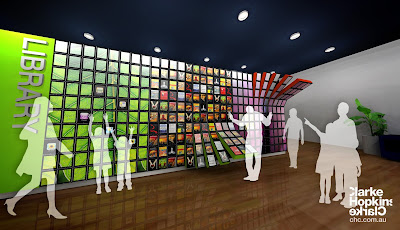The Unviersity of Sydney
SciTech Library opened on Monday. So I went along yesterday to look at their computers for students. The library has an interesting design of modular hexagonal desk for computer users. But laptops are provided for group work in a closed room, which may not be such a good idea.
The BuildingThe library is on the
Darlington Campus, with a pedestrian bridge across the road to the main campus. The SciTech Library combines the technology collections of the university, including architecture, engineering and mathematics.
The library is on Level 1 of the new
Jane Foss Russell Building (160 City Road), which was previously the
Sydney Central building. The building appears to be not quite finished, with the ground floor fenced off. There are two webcams showing progress:
Webcam One and
Webcam Two.
The only way I could find into the library, was through the ajcent student services building. While the building has striking colored panels on tdhe street side, it is a bit dull on the other and the library is discretely tucked in underneath.
The library appears to be on one floor, with most services at the front, books in the middle some student desks at the back and some glass walled teaching rooms along one side. It looks a lot smaller than I was expecting and there is the feeling of being in the basement (although the library is on the first floor).
ComputersThere are some walk up computers outside the library and some just inside the door. The user interface did not seem to have been quite worked out yet. Clicking on the catalog button first brought up a text terminal window, a warning that all you could get to was the catalog and only then the actual catalog.
The general use computers were HP Compaq units with the LCD screen sitting on top on the desk.
A sunken area has one long sit down computer desk made of hexagonal components. Each hexagon had sides of about 900mm, with two computers per hexagon. The hexagons form a meandering line down the middle of the room. Cabling appears to be run under the desks in a central fixed pedestal and run up through grommets in the desktop. The arrangement seems to work reasonably well, in some places forming niches where several students can work together. The desktops are finished in brightly colored laminate (similar in style to the panels on the outside of the building). While the desktops look modular, they appear to be fixed in place.
The hexagonal desk shape looks good and appears workable, but does not appear to make efficient use of space. The workspace for each student curves away from them. With about half of the 900 mm of space taken up by a keyboard and mouse, there is little space for paperwork. The space beyond the 900 mm bends away from them, making it of little use.
Learning RoomsThe far right wall of the library has several learning rooms. The wall is made of multicolored glass (similar in color and patter to the outside of the building). The glass is slightly textured (possibly be the use of a plastic coating to provide the color), but not sufficiently to provide privacy for classes.
The largest room is equipped with seven clusters, each made up of three tables, with two laptops on each table. The tables are the same size hexagons as outside, but are in plain white laminate and are freestanding with one central leg each. Three tables are pushed into a star pattern, but could be separated or make into fewer large arrangements. The cables from the laptops run down in a gap between the tree desks to floor sockets. The desks appear to have no provision for cabling and the gap needed for the cables spoils the aesthetics, but probably has no practical impact.
The room has non-adjustable white plastic chairs, not the height adjustable ones preferable for computer users.
There were no video projectors, white boards or other teaching equipment evident, but the walls of the room are painted mat white and could be projected onto. There is a movable partition wall one third the way down the room, allowing it to be divided in two.
The room is nearby the bookshelves and does not look very inviting. Also the door to enter was not apparent. The glass walls appear to be fixed and the room locked, so that the computers can't be used by library customers when a class is not booked. In addition the use of laptops would make casual use more difficult,. The laptops are different to the desktop computers in the rest of the library. Also laptops make a very desirable target for thieves making it difficult to provide them in an unsupervised room.
The room appears to be designed for group activities with three people per computer, two groups per table. As with the hexagonal desks outside, the desk layout doesn't appear to make good use of space. It is not clear exactly what the room is intended for and perhaps this has not yet been determined. The room is perhaps too large for many educational uses and perhaps a second movable wall, to divide it into three smaller areas would be useful.
The library might want to consider modifying the room to open it out for use when not needed for classes, using a design similar to the
Ezones at University of Queensland.
Labels: classroom design, flexible learning centre, furniture design, Libraries














